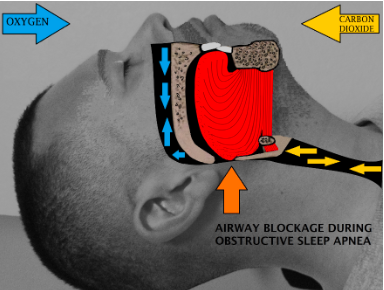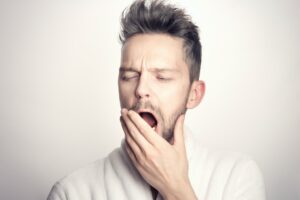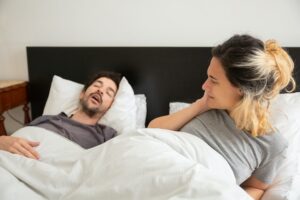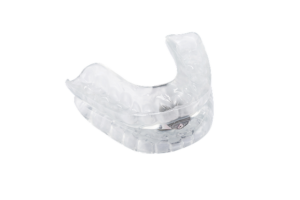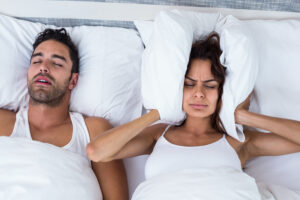Snoring is not uncommon: Nearly 50% of the UK population snore (1).
People may comprehend snoring and sleep apnoea as the same problem, but is it the same thing? To answer that, let us dive into the topic and explore if snoring and sleep apnoea are interchangeable terms.
Snoring is a rattling sound produced due to the vibration or flapping of relaxed muscles/tissues of the mouth and throat when inspired air flows (2). Snoring is not a health issue, but it could ruin the peace of others sleeping with a snorer.
Fact:
The ratio of snoring among males and females in the UK is 2.3:1(3)
Sleep Apnoea (SA), as the name suggests, it means paused breathing (apnoea) during sleep. It is a disorder in which one has alternating/on-off episodes of breathing cessation at night.
It is one of the leading health challenges in the UK. Nearly one and a half million people suffer sleep apnoea, where more than 80% of patients are undiagnosed and have not received treatment, which could have daunting health consequences (4).
Sleep apnoea has two subtypes:
- Obstructive sleep apnoea (OSA) is the most common type and is primarily due to obstruction in the airway. Snoring is one of the symptoms of OSA.
- Central sleep apnoea (CSA) is a rare type that involves improper signalling from the brain to the muscles that control breathing (2).
CSA involves episodic breathing pauses without snoring. OSA-on the other hand- causes alternating episodes of snoring and breathing pauses.
Now, let us come to our question-are snoring and sleep apnoea the same thing?
The answer would be NO.
Snoring can be a symptom, but not all people who snore would have sleep apnoea (1). Physicians found many snorers who had normal sleep study results. It can be because snoring is not a cause of obstruction in sleep apnoea.
One thing that differentiates snoring from sleep apnoea is that, during OSA, the oxygen levels in the body drop to such an extent (≥ 79%) that it awakens the patient from sleep (with a loud snort) to start breathing again (1). Though it lasts a few seconds, and the person falls asleep again without remembering it, frequent waking and sleeping at night decline the sleep quality, resulting in daytime drowsiness and fatigue.
OSA could be questioned if snoring occurs with by the following symptoms:
- High blood pressures
- Snoring louder enough to disturb partner’s sleep
- Brain fog/unable to concentrate
- Chest discomfort at night
- Grasping or choking upon awakening
- Throat soreness when waking up
- Self-observed breathing pauses during sleep
- Daytime dizziness and fatigue (5)
FACT
Intense loud snoring, daytime sleepiness and morning headaches are usual symptoms of OSA (1).
Health conditions that could enhance the risk of snoring associated with sleep apnoea:
- Hypothyroidism
- Adenoids/tonsils
- Obesity
- Muscular dystrophies
- Neurological dysfunctions
- Genetic condition (such as cleft lip palate) (6)
Differences and Similarities Between Snoring and Sleep Apnoea:
Causes:
The causes of snoring and sleep apnoea are very similar and may overlap. For instance, age (old age), gender(male), obesity, airway anatomy, allergy, nasal blockage (deviated nasal septum), poor sleeping position and odd sleeping hours are some of the causes of both snoring and sleep apnoea (1,6).
Fact:
Males have a narrower airway tract than females and are more prone to OSA(1).
However, asthma, hypertension, intense gastric reflux and using sedatives are additional risks for sleep apnoea (2).
Diagnosis:
A detailed patient history (from the bed partner) and a physical examination, preferably by an otolaryngologist (ENT doctor), could help diagnose snoring (7).
However, polysomnography is a (gold standard) diagnostic sleep study test that differentiates simple snoring from sleep apnoea (1,8).
Treatment:
Snoring is not a disease and hence does not need any treatment unless the patient wants-in case of disturbing the partner’s sleep (8).
Besides, treatment is advised based on the severity of the problem. For instance, moderate snoring and sleep apnoea can be eased-off by the following conservative measures:
- Give up alcohol and smoking
- Avoid using sedatives
- Sleep on your side rather than on your back
- Regulate sleep timings and duration
- Maintain a healthy weight/BMI
- Use intranasal steroids or anti-allergy (non-sedatives) sprays for nasal blockage and allergy (1).
Also, dental devices, such as mandibular advancement devices (MAD), can help prevent airway blockage by the tongue. It is helpful in both snoring and OSA.
Another popular method (for moderate to severe OSA) is CPAP (continuous positive airway pressure) device, which adjusts the pressures to keep the airway patent all night (1).
Additionally, surgical treatments are available to resolve obstruction causing sleep apnoea, such as tonsillectomy (removal of tonsils), adenoidectomy (removal of adenoids), tracheostomy (less popular) and uvulopalatopharyngoplasty (removal of tissue from the back of the throat, tonsils, uvula).
Complications:
Snoring does not cause serious health problems except that it could decline the quality of life due to poor sleep.
Obstructive sleep apnoea-on the other hand- has been linked with the risk of serious diseases, such as hypertension, diabetes, atrial fibrillation, stroke and myocardial infarction (heart attack) (9).
According to research published by National Heart, Lung and Blood Institute, nearly 80% of people with sleep apnoea are diabetic and obese (10).
Similarly, sleep apnoea is common among pregnant women due to hormonal changes and weight gain. However, sleep deprivation and sleep apnoea in pregnancy could provoke the risk of pre-eclampsia and diabetes (11).
Besides, driving a vehicle could be dangerous for the snorer due to disturbed or poor sleep. A person with OSA has 12 times more risk of being involved in a car accident, as per NHS (9).
Summary
Snoring is one of the common sleep disorders, and its presentation could be similar to sleep apnoea, but both health problems are a bit different.
Snoring can be a symptom of sleep apnoea, but every snorer may not have sleep apnoea. Obstructive sleep apnoea (OSA) is the most common type, involving intermittent episodes of paused breathing during sleep.
Unlike snoring, OSA causes repeated and brief episodes of awakenings due to significant drops of oxygen levels in the body during sleep.
Snoring could neither cause serious health consequences nor complications. On the contrary, untreated OSA has been linked with daunting health problems such as stroke, diabetes and heart attack.
References (APA 7th edition):
- Bernstein, P., & Ebba, J. H. (2006). Snoring Versus Obstructive Sleep Apnea: A Case Report. The Permanente Journal, 10(1), 21–23. https://www.ncbi.nlm.nih.gov/pmc/articles/PMC3076978/
- https://www.facebook.com/WebMD. (2022). Snoring vs. Sleep Apnea: What’s the Difference? WebMD. https://www.webmd.com/connect-to-care/sleep-apnoea/snoring-versus-sleep-apnoea
- Press. (2018). British Snoring & Sleep Apnoea Association. Britishsnoring.co.uk; British Snoring & Sleep Apnoea Association. https://britishsnoring.co.uk/media.php#:~:text=Snoring%20Facts
- Toolkit for commissioning and planning local NHS services in the UK Obstructive Sleep Apnoea (OSA). (n.d.). https://www.blf.org.uk/sites/default/files/OSA_Toolkit_2015_BLF_0.pdf
- Snoring – Symptoms and causes. (2017). Mayo Clinic. https://www.mayoclinic.org/diseases-conditions/snoring/symptoms-causes/syc-20377694
- Is Your Snoring Really Sleep Apnea? A Guide to Sleep Apnea and How It Can Impact Your Health. (2022). Pennmedicine.org. https://www.pennmedicine.org/updates/blogs/health-and-wellness/2019/december/is-your-snoring-really-sleep-ap-noea#:~:text=Snoring%20that
- Obstructive sleep apnea – Symptoms and causes. (n.d.). Mayo Clinic. Retrieved November 23, 2022, from https://www.mayoclinic.org/diseases-conditions/obstructive-sleep-apnoea/symptoms-causes/syc-20352090#:~:text=With%20obstructive%20sleep%20apnoea%2C%20snoring
- Stuck, B. A., & Hofauer, B. (2019). Clinical practice guideline: The diagnosis and treatment of snoring in adults. Deutsches Aerzteblatt Online. https://doi.org/10.3238/arztebl.2019.0817
- Obstructive sleep apnoea (OSA). (n.d.). Www.nhsinform.scot. Retrieved November 23, 2022, from https://www.nhsinform.scot/illnesses-and-conditions/lungs-and-airways/obstructive-sleep-apnoea/
- Sleep Apnea Research | NHLBI, NIH. (n.d.). Www.nhlbi.nih.gov. https://www.nhlbi.nih.gov/research/sleep-apnea
- Sleep apnea in women: New research could lead to better diagnosis and treatment | NHLBI, NIH. (n.d.). Www.nhlbi.nih.gov. https://www.nhlbi.nih.gov/news/2020/sleep-apnea-women-new-research-could-lead-better-diagnosis-and-treatment

